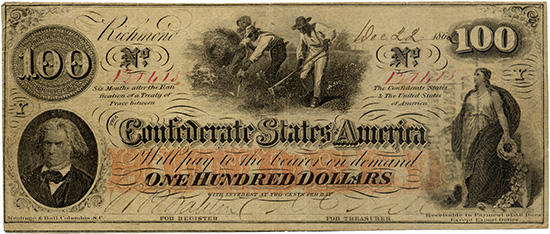The Confederate States of America Banknote

The Confederate States of America banknote was a currency established right before the onset of the Civil War in the U.S. It did not have hard asset backing, but merely a promise to pay back bearers in the event that the South emerged victorious at the end of the war. Given the fact that this didn’t happen, the Confederate dollar rapidly fell out of circulation but in the centuries since has become sought after by currency collectors.
Currency Origins
The Confederate dollar, which was also referred to as the Greyback, was first issued in 1861, when it became clear that the South would engage the North in a military conflict. Initially, it was accepted in many Southern states has a form of exchange with great purchasing power. However, as the war dragged on and it became less certain that the South would win, the amount of Confederate dollars in circulation increased, with their redemption dates being further extended.
As the South started to lose, the currency depreciated rapidly, leading to extremely high prices for basic goods. By the conclusion of the conflict the currency had little value in terms of a medium for exchange. The reason for this is because it was a bill of credit, and as such was not backed by tangible assets. Many historians believe that the Confederate dollar would have held its value much longer had it been backed by assets such as tobacco, gold, silver or even cotton. However, due to the fact that much of this currency has disappeared over the last 140 years, the banknotes that still exist, especially in good condition, carry a very high collection value.
Currency Characteristics
The Confederacy didn’t have access to printing equipment or professional engravers so they had to make do with the materials and designs that were readily available. The notes were known for featuring characters from mythology, particularly the Liberty Goddess. The notes would also feature images of naval ships, black slaves and historical figures such as George Washington, Andrew Jackson and Jefferson Davis.
The majority of bank plates and engravers could be found in the North, so as an alternative the Confederacy had to utilize lithography for their notes. Given the fact that the Union put an embargo on ports owned by the Confederacy, there are numerous variations in terms of paper, plates and printing for Confederate dollars.
The Confederate Dollars would also be signed by different clerks, usually by hand. The first group of notes that were released was signed by the Treasurer and Register specifically. These hand signatures were important as they were considered a method to prevent counterfeiting, but as the war progressed the volume of bills being released exceeded the ability of people to hand sign them. As a consequence women would often be hired for the Treasurer and Register position. The Confederate dollars were issued in a number of different denominations, with the smallest being 50 cents and the largest being $1,000. The total currency issued came to almost $2 billion.


